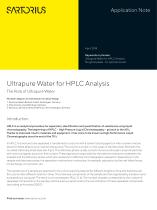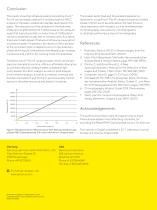
Catalog excerpts

Application Note April, 2014 Keywords or phrases: Ultrapure Water for HPLC Analysis No ghost peaks – for optimal results Ultrapure Water for HPLC Analysis The Role of Ultrapure Water Ms. Katrin Töppner1, Dr. Dirk Hansen2, Dr. Elmar Herbig3 1. Sartorius Stedim Biotech GmbH, Goettingen, Germany 2. Phenomenex, Aschaffenburg, Germany 3. Sartorius Lab Instruments GmbH & Co. KG, Goettingen, Germany Introduction HPLC is an analytical procedure for separation, identification and quantification of substances using liquid c hromatography. The beginnings of HPLC – High Pressure Liquid Chromatography – go back to the 60’s. Thanks to improved column materials and equipment, it has come to be known as High Performance Liquid C hromatography since the end of the 70’s.1 In HPLC, the mixture to be separated is transferred to a column with a solvent (eluting agent) or with a solvent mixture (eluant | mobile phase), by an injector and a pump. The column is a tube, in most cases of stainless steel, filled with the so-called stationary phase (see also Fig. 1). The stationary phase usually consists of porous silica gel or polymer particles with chemical ligands bound on their surface. These ligands are responsible for the selective interactions between the analytes and the stationary phase, which are necessary for effective chromatographic separation. Depending on the sample and stationary phase, the separation mechanisms involved are, for example, adsorption by Van der Waals forces, ion exchange, ion exclusion, etc. The substances of a sample are retained on the column packing material for different lengths of time and therefore exit the column after different retention times. The individual components of the sample are then registered by a detector and evaluated by a computer. The result is a chromatogram (Fig. 1, 5, 6). The number of peaks corresponds to the number of separated components in the sample, and the area is proportional to the concentration of these separated components (according to Kromidas 20001).
Open the catalog to page 1
Employing Arium® Pro VF to Purify Water for Use as an Eluant Among the typical applications for HPLC is sugar analysis. This was performed within the scope of various tests conducted in order to characterize the quality of membranes. On the one hand, membranes were tested for their ability to remove sugar molecules and, on the other hand, the activity of enzyme-immobilized membranes was determined. For this purpose, sugars, such as raffinose, glucose and fructose, were assayed. These types of sugar can be specifically detected by using enzymatic methods like the GOD | POD assay for glucose2...
Open the catalog to page 2
HPLC Column Injector Figure 1: Typical Setup of an HPLC System Materials and Method The samples were analyzed using an HPLC Agilent 1200 Series system (Fig. 4 and Table 1) with a Rezex RNM Carbohydrate Na+ 8 % HPLC column supplied by Phenomenex.6 This column is filled with a cross-linked polystyrene- divinylbenzene-copolymer modified by sodium sulfonate groups and uses an ion exclusion mechanism. This means that analytes are separated based on different ionic interactions. Because of the sulfonate groups on the surface of this column packing material, the pores have a negative charge. As a...
Open the catalog to page 3
Sanitization Port Conductivity Measurement (Inlet Water) Ultrafilter Pump Cartridge 1 Inlet Water Input Reject Water Outlet Conductivity Measurement (Product Water) Final Filter 0.2 µm Product Water Figure 3: Schematic flow diagram of the Arium® Pro VF ultrapure water system (the valves and their controllers are omitted for better clarity). Procedure for HPLC Analysis To prepare for the analytical runs, the Rezex column was heated to 75 °C in the column compartment (heater) and flushed overnight with Arium® Pro VF ultrapure water at 0.6 mL/min. The optical unit of the RI detector was heated...
Open the catalog to page 4
Results To determine the retention times of the individual types of sugar (Table 3), these were prepared and injected individually (Fig. 5). As different sugars interact with the stationary phase to a varying degree, specific retention times are recorded by the RI detector once each sugar has moved through the column. After the individual types of sugar had been determined, a sugar mixture was prepared and separated (Fig. 5). The individual sugar components were separated from one another. The peaks for the different retention times could be allocated to the individual sugar samples...
Open the catalog to page 5
Conclusion The results show that ultrapure water produced by Arium® Pro VF can be readily used as the mobile phase for HPLC analysis of the water-soluble saccharides described in this paper. The interactions of the sample with the stationary phase are not affected by the mobile phase as the ultrapure water that is produced with a conductivity of 0.055 µS/cm can be considered virtually free of contaminants. As a result, there are no salts present that would otherwise cause ghost or phantom peaks.5 In addition, the results of the trials lead to the conclusion that no deposits occur on the...
Open the catalog to page 6All Sartorius Group catalogs and technical brochures
-
OEM
52 Pages
-
Octet® R2 System
7 Pages
-
Unisart® CN 180 DX Membrane
4 Pages
-
Pipette Cleaning
1 Pages
-
continuous air monitoring
6 Pages
-
Pipette Essentials
2 Pages
-
Contamination in Pipetting
4 Pages
-
ABC of pipette tips
1 Pages
-
Vivaflow®
12 Pages
-
Vacusart
2 Pages
-
Sterisart® Sterility Testing
6 Pages
-
Sterisart® NF
4 Pages
-
Sterisart® Family
12 Pages
-
Speedcal Mobile
2 Pages
-
Sartocheck® 5 Plus Filter Tester
26 Pages
-
Rline® Dispenser Module
4 Pages
-
Quintix® and Secura®
24 Pages
-
Picus® and Picus® NxT
8 Pages
-
Midi Plus Pipette Controller
4 Pages
-
Microbiological QC Solutions
12 Pages
-
MA160 Moisture Analyze
8 Pages
-
Filter Papers
36 Pages
-
Cubis® II
12 Pages
-
Claristep® Filtration System
12 Pages
-
Arium® Mini
11 Pages
-
Ultrafiltration Family
96 Pages























































